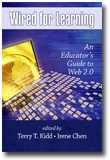
Wired for Learning
An Educators Guide to Web 2.0
By:
Terry T. Kidd, Texas A&M University
Irene Chen, University of Houston-Downtown
Published 2009
"Web 2.0" is a term used to describe an apparent second generation of the World Wide Web that emphasizes collaboration and sharing of knowledge and content among users. With the growing popularity of Web 2.0, there has been a burgeoning interest in education. Tools such as blogs, wikis, RSS, social networking sites, tag-based folksonomies, and peer-to-peer (P2P) media sharing applications have gained a prominence in teaching and learning. With Wired for Learning: An Educators Guide to Web 2.0 there is tremendous potential for addressing the needs student, teachers, researchers, and practitioners to enhance the teaching and learning experiences through customization, personalization, and rich opportunities for networking and collaboration.
The purpose of this text is to clarify and present applications and practices of Web 2.0 for teaching and learning to meet the educational challenges of students in diverse learning setting. This text will bring teachers and university education into a bold new reality and cause them to move to think differently about technology’s potential for strengthening students' critical thinking, writing, reflection, and interactive learning.
CONTENTS
Acknowledgements. Preface. PART I: INTRODUCING WEB 2.0: TRENDS, SIGNS, AND USER DESIGN. The Trend of Web 1.0, Web 2.0, Web 3.0, and Beyond, Te-Ping Kang, Jengchung V. Chen, and Terry T. Kidd. Web 2.0: How Signs, Symbols, and Podcasts Affect Elearning, Ruth Gannon Cook. User Generated Design: Teaching and Learning with Web 2.0, Jeremy I. Tutty and Florence Martin. PART II: SOCIAL LEARNING, NETWORKING, AND THE WEB 2.0. Designing Collaborative Communities of Inquiry through the Application of Web 2.0 Tools, Norm D. Vaughan and D. Randy Garrison. Instructional Design and Pedagogical Issues with Web 2.0 Tools, Amelia W. Cheney, Robert L. Sanders, Nita J. Matzen, and John H. Tashner. Incorporating Web 2.0 Into Education: Instructional Design and Pedagogical Issues, Elena Qureshi and Phillip Olla. Web 2.0 in Academia: Blogs and Wikis as Instruments for Learning and Teaching, Stefanie Panke. PART III: WEB 2.0 ENVIRONMENT AND USER CENTER DESIGN. Wiki Environments for Learning, Johann Ari Larusson and Richard Alterman. Reflective Learning for the Net Generation, John Sandars, Christopher Murray, and Maggie McPherson. SimSpaces: Collaboratively Designed Virtual Learning Environments, Brendan Calandra and Stephen W. Harmon. Course Co-Creation vs. Course Management: Wikis as a Potential Alternative to Traditional Learning Management Systems, ichael L. W. Jones and David Gelb. PART IV: LEARNING MANAGEMENT WITH WEB 2.0. Meaningful Learning with Wikis: Making a Connection, Yufeng Qian. You’ve Got to See This: Looking Back On/Forward from On-Line Hypermediated Art Criticism and Collaborative Digital Technology, B. Stephen Carpenter, II and Pamela G. Taylor. Web 2.0 Affordances for Literacies: Using Technology as Pedagogically Strong Scaffolds for Learning, Julie McLeod and Sheri Vasinda. Semester Without End: Keeping the Class Connection Open via RSS, Ray Schroeder. PART V: WEB 2.0: CASE STUDIES AND IDEAS FOR EDUCATORS. Planning for 21st Century Technologies, Jeff Utecht. Is There a Place in Second Life® for K–12 Education? Amanda Jost and Irene Chen. Uses for Web 2.0 Tools in Instructional Settings, Dominique Turnbow and Andrea Lynch. Designing Professional Development to Support Teachers’ TPACK and Integration of Web 2.0 Technologies, Drew Polly. Technically Speaking: Supporting 1.0 Teachers in a 2.0 World, Jeanne C. Samuel, Jarrod L. Sanson, and Janice M. Hinson. Accessibility Issues for Web 2.0, Becky Sue Parton and Robert Hancock. Web 2.0 in Teacher Education: Characteristics, Implications, and Limitations, Michael M. Grant and Clif Mims. Glossary of Terms, About the Editors.
-
Paperback978-1-60752-096-2
Web price: $45.04 (Reg. 52.99)
-
Hardcover978-1-60752-097-9
Web price: $80.74 (Reg. 94.99)
- eBook9781607522065

- COM023000 - COMPUTERS: Educational Software
- EDU015000 - EDUCATION: Higher
- EDU037000 - EDUCATION: Research
-
 (Re)Envisioning Social Studies Education Research
Current Epistemological and Methodological Expansions, Deconstructions, and Creations
(Re)Envisioning Social Studies Education Research
Current Epistemological and Methodological Expansions, Deconstructions, and Creations
-
 Affirming Identity, Advancing Belonging, and Amplifying Voice in Sororities and Fraternities
Affirming Identity, Advancing Belonging, and Amplifying Voice in Sororities and Fraternities
-
 Effective Alternative Assessment Practices in Higher Education
Effective Alternative Assessment Practices in Higher Education
-
 Expanding the Vision of Faculty Learning Communities in Higher Education
Emerging Opportunities for Faculty to Engage Each Other in Learning, Teaching, and Support
Expanding the Vision of Faculty Learning Communities in Higher Education
Emerging Opportunities for Faculty to Engage Each Other in Learning, Teaching, and Support
-
 Institutional Diversity in American Postsecondary Education
Institutional Diversity in American Postsecondary Education
-
 Promoting Equitable Classroom Practices in Higher Education
Approaches Beyond Curriculum
Promoting Equitable Classroom Practices in Higher Education
Approaches Beyond Curriculum
-
 The Handbook for Aspiring Higher Education Leaders
The Handbook for Aspiring Higher Education Leaders

